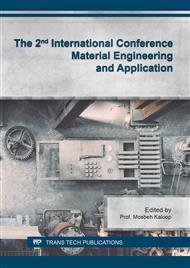[1]
V. N. Azarov, D. P. Borovkov, A. M. Redhwan, Application of swirling flows in aspiration systems, Int. Rev. Mech. Eng., 8(4), 2014, pp.750-753.
Google Scholar
[2]
V. N. Azarov, D. V. Lukanin, D. P. Borovkov, A. M. Redhwan, Experimental study of secondary swirling flow influence on flows structure at separation chamber inlet of dust collector with counter swirling flows, Int. Rev. Mech. Eng., 8(5), 2014, pp.851-856.
DOI: 10.15866/ireme.v8i5.3455
Google Scholar
[3]
V. N. Azarov, I. N. Logachev, K. I. Logachev et al., Methods of reducing the power requirements of ventilation systems Part 4. The oretical prerequisites with swirling air flows, Refract. Ind. Ceram., 55(4), 2014 pp.365-370.
DOI: 10.1007/s11148-014-9728-6
Google Scholar
[4]
V. N. Azarov, N. V. Menzelitseva et al., Main Trends of Conditions Normalizing at Cement Manufacturing Plants, Int. Rev. Civil Eng., 6, 2016, pp.140-145.
DOI: 10.15866/irece.v6i6.6181
Google Scholar
[5]
V. N. Azarov, S. A. Koshkarev, Evaluation of wet dust separator effectiveness in the dedusting of emissions from expanded clay kiln, Mag. Civil Eng., 54(2), 2016, pp.18-32.
DOI: 10.5862/mce.54.3
Google Scholar
[6]
V. N. Azarov et al., Aerodynamic characteristics of dust in the emissions into the atmosphere and working zone of construction enterprises, Int. Rev. Civil Eng., 7(5), 2016, pp.132-136.
Google Scholar
[7]
V. N. Azarov, S. A. Koshkarev, D. V. Azarov, The decreasing dust emissions of aspiration schemes appling a fluidized granular particulate material bed separator at the building construction factories, Proc. Eng., 165, 2016, pp.1070-1079.
DOI: 10.1016/j.proeng.2016.11.821
Google Scholar
[8]
V. N. Azarov et al., Main trends of dust conditions normalizing at cement manufacturing plants, Int. Rev. Civil Eng., 6(6), 2016, pp.145-150.
Google Scholar
[9]
V. N. Azarov, M. V. Trokhimchuk, O. P. Sidelnikova, Research of dust content in the earthworks working area, Proc. Eng., 150, 2016, p.2008-(2012).
DOI: 10.1016/j.proeng.2016.07.282
Google Scholar
[10]
V. N. Azarov, N. S. Barikaeva, T. V. Solovyeva, Monitoring of fine particulate air pollution as a factor in urban planning decisions, Proc. Eng. 150 2016, p.2001-(2007).
DOI: 10.1016/j.proeng.2016.07.279
Google Scholar
[11]
V. N. Azarov, M. V. Trokhimchuk, A. K. Trokhimchuk, Experimental study of the propagation of dust in the construction areas stockpiles, News of higher educational institutions, Geol. Expl., 1, 2016, pp.55-59.
Google Scholar
[12]
M. P. Kyoyken, Source deposits to PM2. 5 and PM10 against the background of the city and the adjacent street, Atmosph. Envir., 71, 2013, pp.26-35.
Google Scholar
[13]
B. Barratt, D. Carslaw, G. Fuller, D. Green, A. Tremper, Evaluation of the impact of dust suppressant application on ambient PM10 concentrations in London, King's College London, Environmental Research Group Prepared for Transport for London under contract to URS Infrastructure & Environment Ltd, November, 2012, 56 p.
Google Scholar


